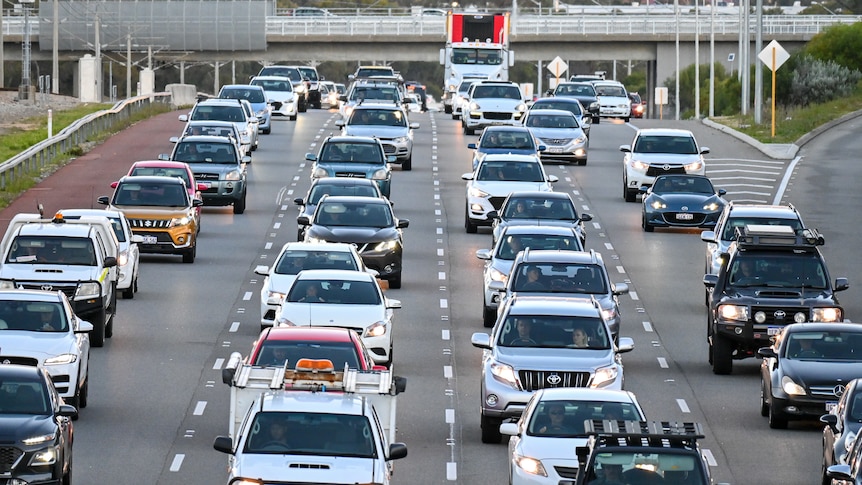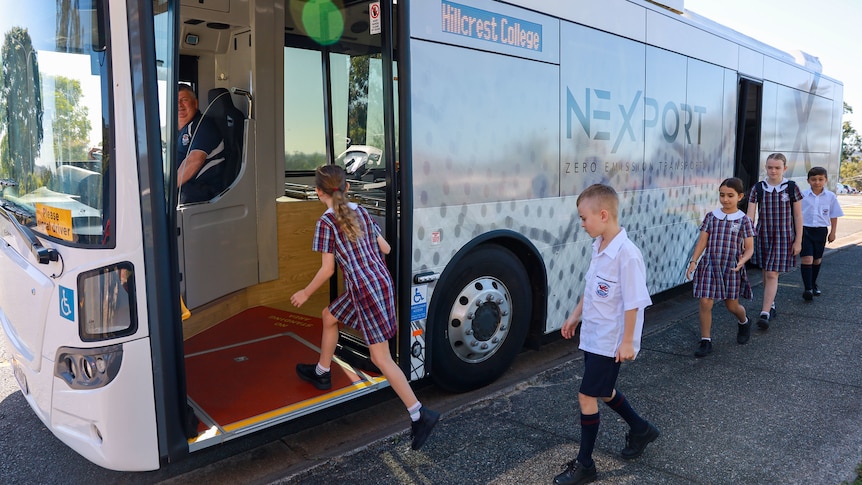Infrastructure WA, the body charged with advising the Premier’s Department on the state’s medium and long-term infrastructure needs, has proposed overhauling road funding by eventually replacing the fuel excise with a road-user charge that also creates incentives to reduce congestion.
Key points:
- Infrastructure WA has made 93 recommendations about the state’s future needs
- The report aims to guide planning and investment for the next 20 years
- The state government is required to respond within six months
The wide-ranging 20-year plan, Foundations for a Stronger Tomorrow, was tabled in State Parliament on Wednesday.
One of the 93 recommendations involves planning for the eventual transition from internal combustion to electric vehicles and how road infrastructure will be funded with the decrease of the fuel excise.
Nicole Lockwood, chair of Infrastructure WA, told Nadia Mitsopoulos on ABC Radio Perth that while the switch to electric vehicles would be “fantastic for the environment and climate change,” it also posed challenges.
“It does mean that the revenue source that comes from our fuel at the moment, that goes towards paying for our roads, will diminish over time,” she said.
“SW [the recommendation] is trying to find a mechanism where the government still has the ability to fund that infrastructure in a way that doesn’t disincentivize people from moving towards electric vehicles.”
EV tax coming in 2027
While the state government has already announced it will introduce a 2.5 cent per kilometer charge for EV’s from mid-2027, Infrastructure WA’s recommendation 58 goes further, proposing that WA work with other states to develop a nationally consistent road user charge that could influence driver behaviour. .
“The scheme has the potential to include vehicle mass, distance, location and time-of-day pricing elements,” the recommendation says.
Such a scheme could potentially charge different rates for road usage in peak hours, or differential rates for different roads.
“What we’ve said is, let’s design a mechanism that has flexibility, so that in time if we wanted to use those levers we could,” Ms Lockwood said.
“We saw it very starkly during COVID, when people were not using the roads during the day, at certain times suddenly we had huge amounts of capacity.
“In the future, when we can’t continue to build more lanes, we will need other mechanisms to be able to manage demand on the system.”
The proposal met with a mixed response from ABC Radio Perth listeners:
Mike: “Again lower socio-economic people who cannot afford to live close to work will pay the most, the system working to keep the gap between the haves and the have nots.”
Greg: “The state government is not incentivizing enough the use of electric vehicles. The proposed road tax is a major disincentive. The benefit to the environment is the major issue and there won’t be the gains there should be. We pay for our roads Mainly via our local government rates so EV drivers will be paying double if we get this bad policy.”
Cynthia: “Surely a toll on cars with only one occupant would make sense? Or a fast lane for cars with two occupants.”
Planning for light rail mooted
The report also recommends the state government look again at the role of light rail and rapid bus transit in Perth’s public transport mix.
A previous plan to link Perth suburbs through the Max Light Rail network was shelved by the Barnett government in 2016, and the McGowan government has been focused on delivering its expansion of the heavy rail network, Metronet.
Ms Lockwood said a plan to link people across suburbs and between stations was still needed.
“We very much back the government’s commitments to Metronet and the heavy rail system, but what we see in the future is a need to look at the next tier of connection for the city,” she said.
“That mid-tier public transport system that links buses and other parts of the network into the Metronet network is really important.
“Part of that is about making sure that the [already identified transport] corridors are protected.
“We really have to think about the spaces we’ve got and how we use them… then the state government needs to then pull a plan together to map that out for the whole of the metro area,” she said.
The infrastructure report also recommended a new desalination plant at Alkimos, a whole-of-government emissions reduction target and a package to reform hospital emergency departments.
The WA Government has six months to respond to the report and is obliged by legislation to respond to each recommendation as well as provide an implementation plan for the ideas that it accepts.
.

